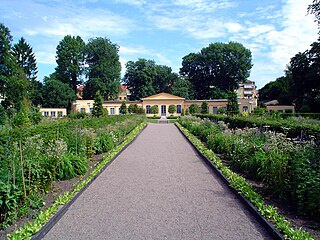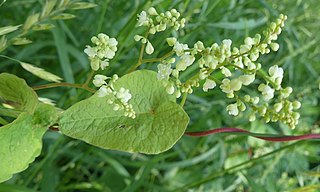
The International Code of Nomenclature for algae, fungi, and plants is the set of rules and recommendations dealing with the formal botanical names that are given to plants, fungi and a few other groups of organisms, all those "traditionally treated as algae, fungi, or plants". It was formerly called the International Code of Botanical Nomenclature (ICBN); the name was changed at the International Botanical Congress in Melbourne in July 2011 as part of the Melbourne Code which replaced the Vienna Code of 2005.

Comptonia peregrina is a species of flowering plant in the family Myricaceae native to eastern North America. It is the only extant (living) species in the genus Comptonia, although a number of extinct species are placed in the genus.

The International Association for Plant Taxonomy (IAPT) is an organization established to promote an understanding of plant biodiversity, facilitate international communication of research between botanists, and oversee matters of uniformity and stability in plant names. The IAPT was founded on July 18, 1950, at the Seventh International Botanical Congress in Stockholm, Sweden. The IAPT headquarters is located in Bratislava, Slovakia. Its president, since 2017, is Patrick S. Herendeen of the Chicago Botanic Garden; vice-president is Gonzalo Nieto Feliner of the Real Jardín Botánico, Madrid; and secretary-general is Karol Marhold of the Plant Science and Biodiversity Centre, Slovak Academy of Sciences, Bratislava.
In botany, the correct name according to the International Code of Nomenclature for algae, fungi, and plants (ICN) is the one and only botanical name that is to be used for a particular taxon, when that taxon has a particular circumscription, position and rank. Determining whether a name is correct is a complex procedure. The name must be validly published, a process which is defined in no less than 16 Articles of the ICN. It must also be "legitimate", which imposes some further requirements. If there are two or more legitimate names for the same taxon, then the correct name is the one which has priority, i.e. it was published earliest, although names may be conserved if they have been very widely used. Validly published names other than the correct name are called synonyms. Since taxonomists may disagree as to the circumscription, position or rank of a taxon, there can be more than one correct name for a particular plant. These may also be called synonyms.
In botanical nomenclature, author citation is the way of citing the person or group of people who validly published a botanical name, i.e. who first published the name while fulfilling the formal requirements as specified by the International Code of Nomenclature for algae, fungi, and plants (ICN). In cases where a species is no longer in its original generic placement, both the authority for the original genus placement and that for the new combination are given.

Coleus barbatus, also known by the synonyms Plectranthus barbatus and incorrectly Coleus forskalaei, is a tropical perennial plant related to the typical coleus species. It produces forskolin, an extract useful for pharmaceutical preparations and research in cell biology.
Blechnum sociale is a species of fern in the family Blechnaceae. It is endemic to Pichincha Province and Azuay Province, Ecuador, but has not been recorded since 1893. The name sociale indicates that they form in colonies. It was first described by Sodiro in 1883. In 1893, Sodiro transferred it to Lomaria as Lomaria socialis. He said that the most similar species was Lomaria stipitellata, now placed in Parablechnum as Parablechnum stipitellatum. The status and taxonomy of Blechnum sociale was unclear as of 2003.

The National Herbarium of Victoria is one of Australia's earliest herbaria and the oldest scientific institution in Victoria. Its 1.5 million specimens of preserved plants, fungi and algae—collectively known as the State Botanical Collection of Victoria—comprise the largest herbarium collection in Australia and Oceania.

Cranfillia fluviatilis, synonym Blechnum fluviatile, is a fern known in the Māori language as kiwikiwi. A herbaceous plant, C. fluviatilis is a "hard fern" of the genus Cranfillia in the family Blechnaceae. It was identified by Patrick Brownsey in 1979. Other common names are star fern, creek fern, kawakawa and kiwakiwa.
Galium hardhamiae is a species of flowering plant in the coffee family Rubiaceae, known by the common name Hardham's bedstraw. The scientific name may be misspelled Galium hardhamae. It is endemic to the Santa Lucia Range of southern Monterey County and northern San Luis Obispo County in California. It is a member of the serpentine soils flora in these coastal mountains. This is a perennial herb forming mats or clumps of stems no more than 30 centimeters long. The stems have many whorls of six fleshy green leaves, each leaf just 1 to 3 millimeters long. The inflorescences, clusters of yellow-green to pinkish flowers, appear in leaf axils.

Vriesea wawrana is a plant species in the genus Vriesea. This species is endemic to Brazil.
Authors of Plant Names by Richard Kenneth Brummitt and C. Emma Powell, 1992, is a print database of accepted standardized abbreviations used for citing the author who validly published the name of a taxon. The database is now maintained online at the International Plant Names Index. The book provides recommended abbreviations for authors' names that help to distinguish authors with the same surname when giving the full name of a taxon. It deals authors who validly published the name of a flowering plant, gymnosperm, fern, bryophyte, algae, fungi or fossil plants. Prior to its publication in 1992, many abbreviations for authors to be cited could be found in Taxonomic literature. A selective guide to botanical publications and collections with dates, commentaries and types. by F. A. Stafleu & R. F. Cowen, 1976–1988.
Cranfillia geniculata, synonym Blechnum geniculatum, is a fern in the family Blechnaceae. The specific epithet refers to the geniculate base of the sterile fronds.

Quercus margarettae, the sand post oak or dwarf post oak, is a North American species of oak in the beech family. It is native to the southeastern and south-central United States from Virginia to Florida and west as far as Texas and Oklahoma. There are historical reports of the species growing in New York State, but it has not been seen there in years.
Zeuxine rolfeana is a deciduous terrestrial orchid belonging to the subfamily Orchidoideae. It is found in South Andaman Island. Its name is also spelt Zeuxine rolfiana.
Ponerorchis tominagae is a species of flowering plant in the family Orchidaceae, native to Taiwan.

Polygonum ciliinode is a species of flowering plant in the family Polygonaceae, native to central and eastern Canada, and the north-central and eastern United States. The specific epithet is also spelt cilinode.

Taxon is a bimonthly peer-reviewed scientific journal covering plant taxonomy. It is published by Wiley on behalf of the International Association for Plant Taxonomy, of which it is the official journal. It was established in 1952 and is the only place where nomenclature proposals and motions to amend the International Code of Nomenclature for algae, fungi, and plants can be published. The editor-in-chief is Dirk C. Albach.

Hypericum collenetteae is a species of flowering plant of the St. John's wort family (Hypericaceae) that is found in Saudi Arabia.
Cyperus setigerus is a species of sedge that is native to central and southern parts of the United States, recorded from Kansas, Oklahoma, Texas, Missouri, and New Mexico.











